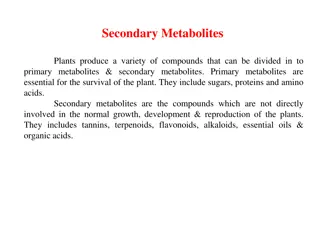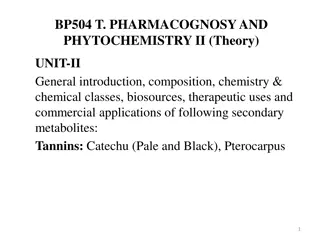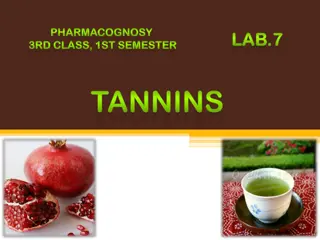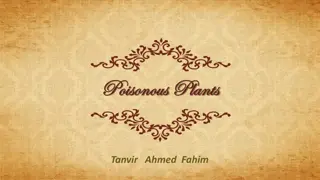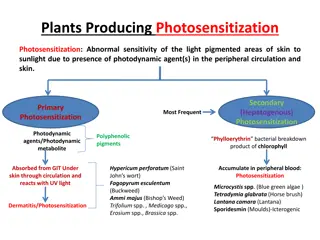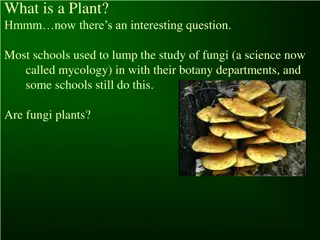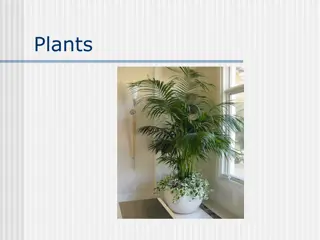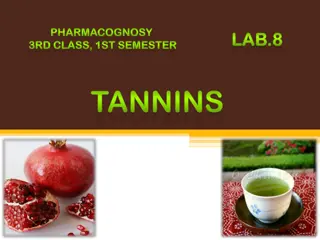Understanding the Classification of Tannins in Plants
Tannins, derived from French "tanin," are natural polyphenols found in plants with astringent properties. They can be classified into true tannins and pseudotannins based on the Goldbeater's skin test. Hydrolysable tannins can be further categorized into gallotannins and ellagitannins, while condensed tannins, also known as proanthocyanidins, are nonhydrolysable. These classifications are based on the chemical structure and reactions of tannins, highlighting their diverse properties and uses in various plant species.
Download Presentation

Please find below an Image/Link to download the presentation.
The content on the website is provided AS IS for your information and personal use only. It may not be sold, licensed, or shared on other websites without obtaining consent from the author. Download presentation by click this link. If you encounter any issues during the download, it is possible that the publisher has removed the file from their server.
E N D
Presentation Transcript
TANNINS Name tannin derived French tanin (tanning substance), denotes range of natural polyphenols. Tannins- complex organic, nonnitrogenous plant products, generally have astringent properties. Denotes large group of compounds, distributed in the plant kingdom. Term tannin - first used by Seguin , 1796 to denote substances having ability to combine with animal hides to convert them into leather which is known as tanning of the hide. According to this, tannins are substances which are detected by a tanning test due to its absorption on standard hide powder test is Goldbeater s skin test.
TANNINS CLASSIFICATION Two major groups on the basis of Goldbeater s skin test. True tannins- show positive tanning test, high molecular weight compounds, complex polyphenolics Pseudotannins- partly retained by the hide powder and fail to give the test Based on hydrolytic reaction and nature of phenolic nuclei involved in the tannins structure, Two major chemical classes of tannins: hydrolysable tannin * condensed tannins Hydrolysable Tannins: hydrolysed by mineral acids or enzymes such as tannase. Invloves many molecules of polyphenolic acids such as gallic, hexahydrodiphenic, or ellagic acids, bounded through ester linkages to a central glucose molecule On the basis of the phenolic acids produced after the hydrolysis, they are further categorized under Gallotannins composed of gallic acid or Ellagitannins -contains hexahydrodiphenic acid which after intraesterification produces ellagic acid.
TANNINS CLASSIFICATION Hydrolysable tannins- Known as pyrogallol tannins- as the components of phenolic acids on dry distillation are converted to pyrogallol derivatives. They are soluble in water, and their solution produces blue colour with ferric chloride.
TANNINS CLASSIFICATION Nonhydrolysable or Condensed Tannins/ proanthocyanidins not readily hydrolysable to simpler molecules with mineral acids and enzymes, contain only phenolic nuclei which are biosynthetically related to flavonoids. Catechin, found in tannins is flavan-3-o1, leucoanthocyanidins are flavan-3,4-diol structures. linked to carbohydrates or protein molecules to produce more complex tannin compounds. Treated with acids or enzymes, polymerize yielding insoluble red coloured products phlobaphens Phlobaphens give red colour to many drugs such as cinchona and wild cherry bark. On dry distillation, they yield catechol derivatives.
TANNINS CLASSIFICATION Nonhydrolysable or Condensed Tannins/ proanthocyanidins Condensed tannins are also soluble in water and produces green colour with ferric chloride. include Rosaceae, Geraniaceae, Leguminosae, Combretaceae, Rubiaceae, Polygonaceae, Theaceae, etc Cruciferae and Papaveraceae - totally devoid of tannins
TANNINS CLASSIFICATION Pseudotannins Pseudotannins are simple phenolic compounds, low molecular weight. do not give Goldbeater s skin test. Gallic acid, Chlorogenic or the simple phenolics such as catechin are pseudotannins found in plants, especially in dead tissues and dying cells. PROPERTIES OF TANNINS 1. Give colloidal solutions with water. 2. Non crystalline substance. 3. Soluble in water (exception of some high molecular weight structures), alcohol, dilute alkali, and glycerin. 4. Sparingly soluble in ethyl acetate. 5. Insoluble in organic solvents, except acetone. 6. Molecular weight ranging from 500 to >20,000. 7. Oligomeric compounds with multiple structure units with free phenolic groups. 8. Can bind with proteins and form insoluble or soluble tannin protein complexes.
TANNINS ID TEST Goldbeater s skin test: Goldbeater s skin is a membrane from the intestine of Ox. It behaves just like untanned animal hide. A piece of goldbeaters skin previously soaked in 2% HCl + wash D H2O + placed in a solution of tannin for 5 minutes + wash with D H2O and transferred to 1% FeSO4solution. A change in colour of the goldbeater s skin to brown or black indicates the presence of tannin. Hydrolysable and condensed tannins +ve pseudotannins show very little colour or ve test. Phenazone Test: 5 ml of aq. Sol. of tannin containing drug+0.5 g of sodium acid phosphate. Warm, cool, and filter + 2% phenazone solution to the filtrate. All tannins are precipitated as bulky, coloured precipitate Gelatin Test: 1% gelatine solution, + little 10% sodium chloride + 1% sol. of tannin precipitation of gelatine from solution.
TANNINS ID TEST Test for Catechin (Matchstick Test): is modification phloroglucinol test for lignin. Matchstick contains lignin. Dip a matchstick in the dilute extract of the drug, dry, moisten it with Conc. HCl, + warm it near a flame. Catechin in the presence of acid produces phloroglucinol which stains the lignified wood pink or red. Test for chlorogenic acid: A dilute solution of chlorogenic acid + extract + aq. NH3, exposed to air, slowly turns green presence of chlorogenic acid. Vanillin-hydrochloric acid test: Drug + mixture of vanillin: alcohol : dilute HCl (1:10:10) The reaction produces phloroglucinol which along with vanillin gives pink or red colour.



